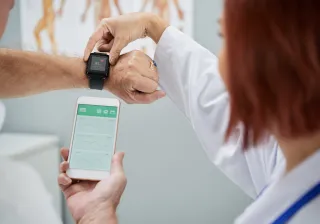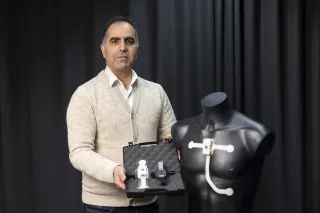The COVID-19 pandemic has challenged our health care and diagnostics. Concomitantly, remote work has created an increased need for ways to monitor well-being and support healthy lifestyles. Health technology has been key in developing solutions for these critical needs. The sector is also very promising for the Finnish economy.
Health technology is a EUR 2.1 billion sector in Finland. Key economic indicators show an outstanding development over the past ten years, says Chief Research Scientist Martti Kulvik from ETLA Economic Research. The sector's turnover, profit and added value have grown superbly compared to the average Finnish business sector. Additionally, health technology employs 50% more people than ten years ago.
The long and steady development of the sector is a strong indicator of a continuing trend. The future looks promising: the number of companies has grown steadily and there is a multitude of flourishing SMEs, which means opportunities for further growth of the sector.
– The success story of health technology has somewhat flown under the radar, says Kulvik.
Diagnostics as part of everyday life
The number of respiratory tract infection tests has increased 10–100 times during the COVID-19 pandemic. Diagnostics is shifting from central laboratories to decentralised systems and towards personal monitoring, says Research Professor Jussi Hiltunen from VTT.
Test samples are still mainly analysed in central laboratories, but processes such as inflammation analyses are carried out locally in health centres. The third option would be for people to test the samples themselves. There is already technology available for personal monitoring: examples include single-use smart plasters for monitoring vital signs and biochemical rapid tests for COVID-19.
The introduction of technology is slowed down by matters such as the interpretation of legislation and utilising several technologies in these solutions.
– Commercialisation could be accelerated by further strengthening cooperation between universities, research institutes and companies. This is what we do, for example, in the Future of Diagnostics project coordinated by VTT, Hiltunen says.
Rapid antigen tests effective in pandemic management
COVID-19 tests are based on three different principles: PCR tests that measure exposure, blood tests that measure antibodies, and antigen tests for measuring whether someone has an acute disease or is currently infectious.
– According to scientific evidence, what is crucial for managing the pandemic is how quickly you get the results and how often people are tested. The sensitivity of the tests is significantly less important. Rapid antigen testing is the most effective method of managing the pandemic, as it provides quick information on the threat of infection, says Janne Koskinen, R&D Director at ArcDia Oy.
Antigen tests would serve best testing at border crossing points: getting results while you wait is more effective in preventing the spread of infections carried by passengers compared to centralized testing. However, PCR is currently the most common method in Finland. One reason is its higher rate of reimbursement from Kela - the Social Insurance Institution of Finland. According to Koskinen, the rate of reimbursement should be based on effectiveness and not on the price of technology.
– In Finland, the pioneers of antigen testing are private health care and Lapland. The interpretation of legislation and various practices have slowed down the introduction of new diagnostics elsewhere, Koskinen says.
The pandemic restrictions prevent other viruses from circulating. Therefore, humankind is collecting a debt on immunity. At the same time the prediction of future flu vaccine strains is difficult because influenza is not circulating. We may expect intense flu seasons and a huge demand for diagnostics also at the end of the pandemic. The diagnostics should identify also other viruses such as influenza and RSV.
– Finland has significant development expertise and manufacturing capacity to combat the pandemic. We should make smart investments that will also be useful in diagnosing other diseases in the post pandemic era, Koskinen says.
Supporting healthy lifestyles with technology
During the pandemic, more than one million Finns have switched to remote work. This has changed our health habits. Lifestyle plays an important part in our well-being due to the fact that behaviour explains up to 40% of health. Most lifestyle diseases could be prevented by a change of lifestyle. This would reduce health care costs and improve quality of life. Making changes in behaviour is possible, but people often find it difficult.
– Forming new habits is simple: a situation that repeats often in everyday life can be combined with a small behaviour. Technology could make this much easier. For example, in the Pienet Teot (‘BitHabit’) application developed in cooperation between VTT, the University of Eastern Finland and the Finnish Institute for Health and Welfare, the user can select small habits from a list containing more than 400 healthy habits, monitor them and get feedback. In the future, the aim is to develop applications that are increasingly individualized, enabling identification of high-risk lifestyle situations and providing support exactly at those times, says Senior Scientist Elina Mattila from VTT.
Technology can support the well-being of knowledge workers
Remote work has particularly affected the everyday lives of knowledge workers. Firstbeat Technologies has been monitoring the well-being of information workers for years. Their measurements indicate that the time spent on recovery from stress increased significantly at the beginning of the pandemic. Initially, people were sleeping 14 minutes more daily, a return to the figures of the early 2000s. But by October, the effect had almost disappeared. According to monitoring data, some knowledge workers stopped doing physical activity nearly entirely while working remotely. The restrictions had two effects on absence due to illness: absences due to mental health reasons increased whereas absences because of other illnesses decreased.
The pandemic will fade eventually, but remote work has come to stay. It has many advantages, but also challenges.
– Employees' responsibility for self-management is increased, and it is more difficult to manage your workload while focused or under pressure. Issues do not appear as absences, but rather as reduced work ability, says CTO Ilkka Korhonen from Firstbeat Technologies Oy.
Technology can help balance stress and recovery. Factors that cause stress or support recovery are unique: the same meeting can be stressful for one person and energising for another. Health technology helps us identify individual variations better.
– For the employer, technology makes it possible to monitor their employees’ well-being and workload. Of course, you need to be mindful of information security: the employer won't see individual results, but they can look at group level results to see changes and address problems. When used correctly, technology helps to manage the overall workload and supports employers as they manage remote knowledge work, Korhonen says.




